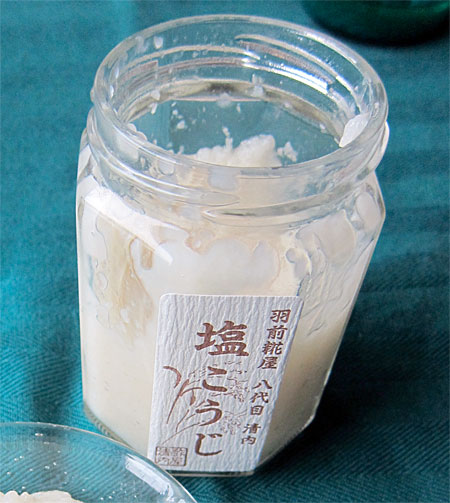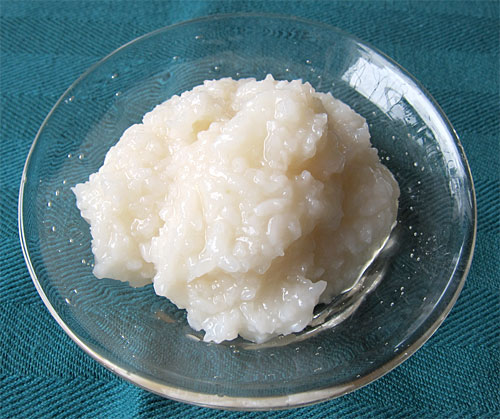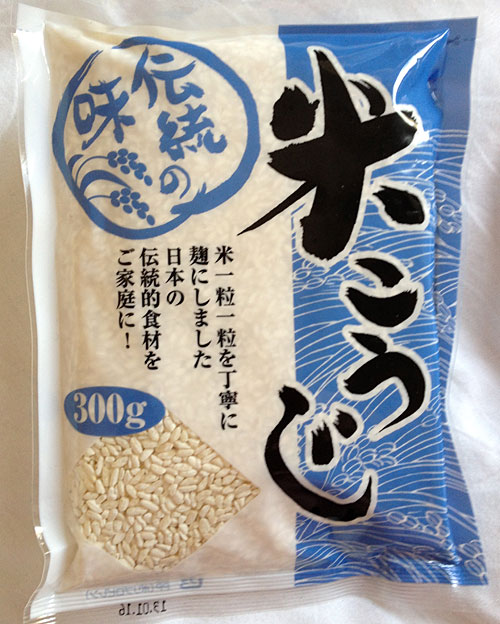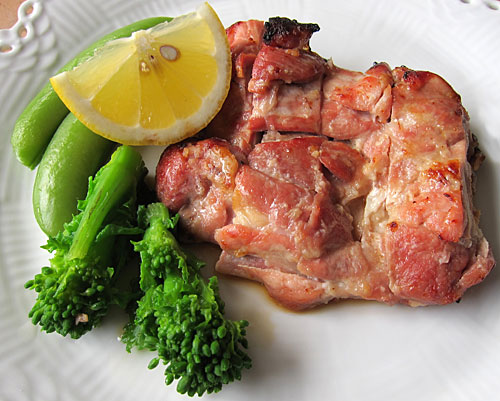Shio-kōji (salt kōji) article in The Japan Times
On Just Hungry and its sister site, Just Bento, I usually stick to ingredients that are fairly easy to get anywhere, especially if you have access to a decent Japanese grocery store. But since the target audience for my monthly Japan Times articles are English speakers who live in Japan, I sometimes write about foodstuffs that you can only get in Japan.
This month's subject is shio-kōji (塩麹), a traditional ingredient that is quite trendy in Japan right now. As I explain in the article, shio-kōji is just rice, kōji-kin fungus and salt that has been fermented or matured for about a week. (Before you get all squeamish about 'fungus', remember that beneficial bacteria, molds and fungi are used to make foods such as cheese and yogurt too, not to mention miso, soy sauce, and beer!) Shio-kōji is rather like a mild miso without the soy flavor - it has plenty of umami, and is salty but not overwhelmingly so.
In Japan, it's quite easy to get ready-made shio-kōji these days. If your local supermarket doesn't have it, try a department store food hall. Or, look on Rakuten or Amazon Japan for mailorder sources.
This is a jar of a shio-kōji made by an old traditional miso maker. It's pricey but delicious, with a nice balance of salt and umami.

It looks just like a rice porridge (okayu in Japan or congee in China), or even rice pudding.

Making your own shio-kōji
So you're not in Japan, but you want to try shio-kōji. At the moment it doesn't seem to be available at Japanese grocery stores outside of Japan yet (as of February 2012). (I checked a at Mitsuwa in Edgewater, NJ and Nara Foods in Port Washington, NY both of which are pretty well stocked stores, and neither had it.) So the only option is to make your own.
If you can find kome-kōji, or rice-kōji, steamed rice that has already been innoculated with the kōji-kin fungus, the process is quite easy. Dried kome-kōji is very handy since it keeps indefinitely until it's needed. This is what I use. Turning dried kome-kōji to ready-to-use shio-kōji takes a week or so. I store excess shio-kōji in the freezer, and that works out great. I brought a few bags back with me from Japan, but if I run out before I'm back there again I will probably order more from Amazon Japan or Rakuten and either have my mom send it to me or use a shipping service. (See overseas shipping services).

You can also try doing an online search for 'rice koji', which turns up some mailorder sources. Usually they list 'organic brown rice koji', which should work fine for making shio-kōji (though the organic and brown rice bits are fairly meaningless nutrition-wise, since you use so little of it per serving). Your local Japanese grocery store may have premade, non-dried (fresh) kome-kōji available, especially around this time of year since it's used to make amazake, a traditional Girl's Day (March 3rd) beverage. It usually comes in tubs, and can be found in the refrigerated section.
Just follow the instructions in the Japan Times article, and in a week you'll have a batch of shio-kōji. You'll need to add more water if you're using dried kome-kōji (about 1.5 times the weight of the dried kome-kōji).
If you can't find kome-kōji or you are feeling adventurous, you can buy kōji-kin spores by mailorder and make your own kome-kōji, using the rice of your choice. This is a bit tricky but can be done. See the bottom of this article for some sources for kōji-kin spores.
I am still in the early stages of experimenting with shio-kōji, but so far I think my favorite way to use it is as a marinade for chicken or fish. Here is a piece of chicken (the thigh, boned) which was just marinated in shio-kōji by spreading both sides with a thin layer of shio-koji (a tablespoon or so total), wrapped tightly in plastic and left in the refrigerator for about 40 minutes. No other seasonings were used, though a dash of pepper wouldn't hurt it at all. It was juicy and delicious. And look at that color! That comes from the naturally occuring sugar in the shio-kōji caramelizing.

I would really like to see shio-kōji become popular around the world, and I don't see why it can't be. It's especially good for people who have trouble with wheat gluten or soy, either or both of which are in miso and soy sauce. Shio-kōji is packed with umami, but only uses rice and salt.
Links
- Kōji - Japan's hidden ingredient - the Japan Times article
Mailorder sources for kōji-kin spores - all merchants here will ship the spores worldwide (though maybe not other items in their catalogs):
- Gem Cultures - get the Light Rice Starter for amazake, white miso, etc. Also a source for natto-kin to make your own natto!
- Northern Brewer - order their 'sake kit'
- Vision Brewing
Personal note
We are gradually recovering from the shock of the burglary, though they left such a horrendous mess behind that it's going to take a while to clean it up. But I am feeling a bit better - we already signed up to get a security system installed, and our contractor will block up that vulnerable side door as soon as the insurance inspector comes to take a look at it. Both The Guy and I would like to thank every one of you who sent words of encouragement and sympathy - they really, really helped! A big hug to you all.
If you enjoyed this article, please consider becoming my patron via Patreon. ^_^

 Welcome to Just Hungry, where we serve authentic Japanese recipes and more! I'm
Welcome to Just Hungry, where we serve authentic Japanese recipes and more! I'm 













Comments
anon.
27 February, 2012 - 15:05
Permalink
Re: Shio-kōji (salt kōji) article in The Japan Times
Doing a few Google searches, I found this German shop:
Koji Shop.
He sells several different strains(?) for use with different bases:
Koji A is used to make rice - miso
Koji B is used to make barley - miso
Koji C is used to make soy bean - miso
Koji D is used to make sake, amasake and mirin
Koji E is used to make koji pickles
Koji F is used to make shoyu (soy sauce)
500g cost between €7.50 to €10.00 including shipping.
HTH
maki
27 February, 2012 - 19:12
Permalink
Re: Shio-kōji (salt kōji) article in The Japan Times
Looks good! Thanks for sharing the link!
Loretta
27 February, 2012 - 18:37
Permalink
Re: Shio-kōji (salt kōji) article in The Japan Times
Thanks Maki, perfect timing for me. Have my first extended stay with otousan very soon and my husband won't be joining us until later in the month. This is where everything I learned from you over the years will truly come into its own.
Bet he'll be surprised when I unpop a jar of shiokoji. I'm very keen to try it!
Sylvia S. B. S.
27 February, 2012 - 19:56
Permalink
Re: Shio-kōji (salt kōji) article in The Japan Times
Please give some more uses for this. It's not clear (to me) what the purpose is, beyond the chicken marinade. Thanks.
maki
27 February, 2012 - 20:07
Permalink
Re: Shio-kōji (salt kōji) article in The Japan Times
I've listed several uses in the Japan Times article. It's really nice in a salad dressing (recipe in the article), and can be used instead of or in addition to other salty condiments like soy sauce, Worcestershire sauce, miso or salt in cooking. Adding some to a sauce for instance, or to a soup, marinating fish or meat or vegetables...etc. I like my oatmeal salty rather than sweet, and it even makes an interesting addition to that. I am still discovering new ways to use it myself!
Sylvia S. B. S.
29 February, 2012 - 21:58
Permalink
Re: Shio-kōji (salt kōji) article in The Japan Times
Oops ... I overlooked the link! Now I get it! Sounds very interesting as a new taste for many of us. Thank you.
gilda92
28 February, 2012 - 05:27
Permalink
Re: Shio-kōji (salt kōji) article in The Japan Times
Oh dear! Maki tell me this is not the next Sriracha! One month from now every newspaper food crik is going to be talking about Shio-koji. Happily though, it will replace Sriracha which seems to turn up in every recipe or restaurant critique right now.
Romina
28 February, 2012 - 08:57
Permalink
Re: Shio-kōji (salt kōji) article in The Japan Times
I'm so glad to hear you are recovering from the shock.
It makes me happy to see your article about shio-kōji, because I've been curious about ever since seeing it being used in a Japanese dorama called "Osen". They used it to pickle vegetables, fish and ultimately pork. In the dorama you can see them making it, but now I understand it's not made with just plain rice. I'm definitely going to find it and experiment with it ^_^
The chicken on the picture looks delicious by the way!
JennyO
28 February, 2012 - 21:41
Permalink
Re: Shio-kōji (salt kōji) article in The Japan Times
I was able to find some Fresh Koji at Uwajimaya in Seattle. Did you use any particular kind of salt?
zuza
29 February, 2012 - 14:07
Permalink
Re: Shio-kōji (salt kōji) article in The Japan Times
i will defo be trying this, i love the umami flavour and even made umami porrige the other day if you fancy checking it out...
http://cheesy-mash.blogspot.com/2012/02/savoury-porridge.html
zx
Mathilde
29 February, 2012 - 23:58
Permalink
Re: Shio-kōji (salt kōji) article in The Japan Times
Thank you again for this bright article, although in Japan for almost a year, I had'nt yet heard of it !
emi r
4 March, 2012 - 22:20
Permalink
Re: Shio-kōji (salt kōji) article in The Japan Times
Thanks for the timely post. You are always so thorough with your information. I just received a bag of dried shio-koji from my mom, but have never used it before. I think I'll make pickles.
Kate
15 March, 2012 - 07:36
Permalink
Re: Shio-kōji (salt kōji) article in The Japan Times
I was so happy to see this article. The shop that initially popularized shiokoji is Saiki Koujiya Honten and Myoho is the woman there who has worked tirelessly to spread the word about koji and shiokoji. They have an English website kojiya.jp Their Japanese website is saikikoujiya.com I have been working with them to build a larger international audience. There are lots of recipes on the English website.
Gerry Gomez Pea...
4 April, 2012 - 14:28
Permalink
Re: Shio-kōji (salt kōji) article in The Japan Times
Like everything you write, this article is very informative. Thank you for all you do to share the beauty of Japanese cuisine.
I will soon be attempting to make shiokoji here in Brooklyn. I am excited, because I bought some lovely shio in Okinawa last fall and feel this will be a great use for that.
On a related note, I am having difficulty locating articles/recipes on how to use kome-koji for making pickles. I bought some dry kome-koji last weekend at Mitsuwa on a lark and wanted to extend my pickle-making efforts to incorporate kome-koji.
Do I begin by soaking the kome-koji in water to produce the "oatmeal-like" consistency you describe in the shiokoji method? And then just submerge the cut-up vegetables (daikon, carrots, etc.) inside this mixture of kome-koji and water? Should I also add salt? And is there a waiting period between making the mixture and adding the vegetables? I'd welcome your guidance!
Alternatively, once I make shiokoji, would it be possible to use that to create a longer fermented pickle (vs. the overnight "quick pickles" you provided a recipe for)?
Thank you in advance for your advice. (I also noticed your comment about having recently been burglarized—I went through a similar experience last summer and I can sympathize. I wish you the best, and thank you again for your great work and generous spirit.)
maki
5 April, 2012 - 15:26
Permalink
Re: Shio-kōji (salt kōji) article in The Japan Times
Kome-koji alone without salt will not produce good pickles. You need to turn it into shio-koji, then you can use it for overnight pickles. (Instructions are in the JT article.) Just take out enough from your batch to coat your vegetables thoroughly, put in a bowl or plastic bag and leave in the fridge.
Gerry Gomez Pea...
3 July, 2012 - 17:21
Permalink
Re: Shio-kōji (salt kōji) article in The Japan Times
Belated thanks for answering my question!
I look forward to trying this soon. I'm excited because I've been growing daikon, burdock, Japanese turnips, and Kyoto red carrots in my garden this year...all of which I think will take well to this pickling approach.
Again, thank you!
Sandy
12 November, 2012 - 02:58
Permalink
Re: Shio-kōji (salt kōji) article in The Japan Times
Thank you for all the information on the shio koji. I bought some koji and made it. I have it in a jar for about 8 days now and stir it everyday. It is white and thick, but it smells like alcohol and taste a bit sour. From reading the article, I was expecting something salty and sweet with a slight sake-like smell. But, what I have seems pungent. Is there something wrong?
Marina Ota
23 May, 2013 - 02:05
Permalink
Re: Shio-kōji (salt kōji) article in The Japan Times
Dry Shio Koji in individual 10g x 6 packets can now be bought online at Japan Super. Simply sprinkle on meat, poultry or fish. Marinates in as little as 20 minutes or longer for more flavor.
JennyO
1 July, 2013 - 22:32
Permalink
Re: Shio-kōji (salt kōji) article in The Japan Times
Uwajimaya in Seattle just started selling already made Creamy Shio Koji Sauce. I was buying the Koji and mixing it with Celtic Seasalt. I can't tell you how much my husband and I love this ingredient for summer BBQs! I am going to try my hand at Salad dressing next. Thanks for the great tip!
maki
2 July, 2013 - 13:57
Permalink
Re: Shio-kōji (salt kōji) article in The Japan Times
Awesome! Thanks for reminding me also that I need to post some more about shio-koji soon ^_^
Adam K
3 September, 2013 - 13:57
Permalink
Re: Shio-kōji (salt kōji) article in The Japan Times
If you have the EXCELLENT Toshiba yoghurt maker (TYM-1000-W) you can make your own Natto, Kome-koji and yoghurt since you can change the temperature setting.
For kome-koji use 32 degrees (for Miso, for Sake it would be 35-36), Natto 45 degrees (Celcius)
Steam rice, don't cook it. Just made 10kg of Miso using own kome-koji.
Thanks for this detailed website.